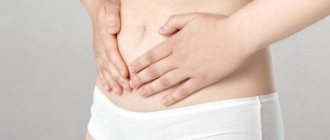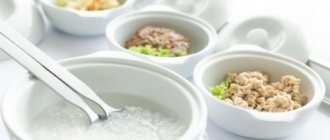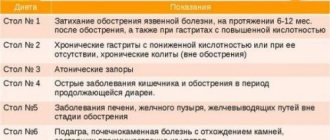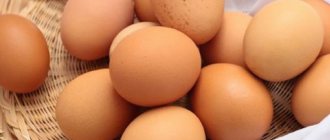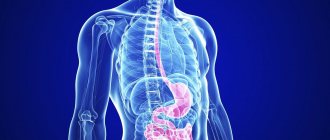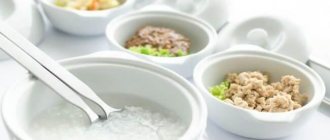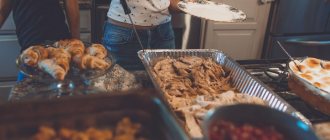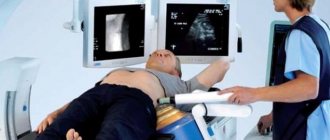General rules
A perforated gastric ulcer is a complication of peptic ulcer disease and occurs as a result of the progression of destructive processes in a chronic ulcer.
Perforation is promoted by a sudden increase in intra-abdominal pressure (for example, lifting weights or abdominal trauma), stress on the digestive organs (alcohol, rough food), and stress. Visually, a through defect is noted in the wall of the stomach, as a result of which the contents of the stomach enter the abdominal cavity, acts as an irritant and leads to peritonitis (serous-fibrinous and purulent). When a stomach ulcer is perforated, it develops quickly (in 2-3 hours).
The body’s primary reaction to perforation is pain shock (sharp, dagger-like pain in the epigastrium) and possible loss of consciousness. Due to the spread of exudate, the pain quickly spreads throughout the abdomen and radiates to the supraclavicular region to the left. Nausea and reflex vomiting, dry mouth and weakness often appear. Perforation of an ulcer is an indication for urgent surgery, and the choice of method depends on many factors and indications. Conservative treatment is possible only as a temporary forced measure in very serious condition of the patient and in the case of covered perforation, when there are no symptoms of peritonitis .
The operation most often involves suturing perforated ulcers. With the use of modern medical technologies, it is possible to perform video endoscopic operations, as well as suturing the hole using the Endo Stitch device.
The suturing area is peritoneized by the omentum, and the tightness of the sutures is checked by pumping air through the probe. The disadvantages of this method of operation are the possibility of repeated recurrence of the ulcer in 50-60% of patients, incomplete sealing of the sutures and narrowing of the lumen of the gastric outlet. More radical operations are gastrectomy, vagotomy and excision of the ulcer with gastric drainage surgery.
Gastric resection is performed with a long history of ulcers, callous ulcers and repeated perforation. To perform resection, the absence of widespread peritonitis is necessary. The postoperative period includes therapeutic nutrition.
Diet after surgery
Nutrition begins with surgical Diets No. 0A , 0B , 0B . They provide unloading and sparing of the stomach, prevent the appearance of bloating, since they contain a minimal amount of food nutrients. A perforated gastric ulcer and the condition after its surgical treatment is a serious disease and requires gradual restoration of gastric function. The diet during this period should contain easily digestible foods and a gradually increasing amount of proteins, fats and carbohydrates while sharply limiting salt intake.
On the first postoperative day after surgery, hunger is indicated, and from the second day warm sweet tea (250 ml) and rosehip infusion (50 ml) are administered. They are given every 20 minutes, a teaspoon. From 3-4 days, with normal peristalsis, the patient is prescribed Table No. 0A (it is supplemented with two soft-boiled eggs). A week after the operation, it is possible to transfer to Table No. 0B , and after 9 days - No. 0B .
- Table No. 0A is the lowest in calories and contains only 10 g of protein, 15 g of fat and up to 200 g of carbohydrates. The diet consists of mucous decoctions into which cream is added, weak meat broth, berry jelly (or jelly), rosehip infusion and juices. Food is only in liquid form in portions up to 250 g, meals are organized 7-8 times a day. Pureed foods, carbonated drinks and whole milk, which can cause bloating, are not allowed.
- Table No. 0B already contains more basic nutrients (50 g of protein and fat each), no more than 4 g of salt and 250 g of carbohydrates. Food is allowed in liquid and puree form, and the portion size is increased to 400 g. The diet is expanded with slimy cereal soups, steam omelettes or soft-boiled eggs, pureed rice and buckwheat porridge in liquid form, pureed lean meat and fish.
- Table No. 0 B already contains 80-90 g of proteins, 320 g of carbohydrates and 70 g of fat. The amount of salt allowed has also been increased (6-7 g). Puree food is consumed 5-6 times a day. Additionally, pureed meat and fish, pureed soups and creams, pureed cottage cheese with added cream, kefir, yogurt, baked apples, fruit and vegetable puree, white crackers in small quantities (up to 75 g) are included.
The duration of each of these diets is on average 2-4 days, which depends on the volume of the operation performed and the patient’s condition (they can be lengthened or shortened). Subsequently, the patient is transferred to Diet No. 1B (mashed version). Meals up to 5-6 times, its volume - 250 g of pureed dish and a glass of liquid. Start eating this diet in the hospital and continue at home. It includes:
- Puree soups from cereals (oatmeal, semolina, rice, buckwheat). They add an egg-milk mixture or cream, as well as butter. It is allowed to add pureed vegetables (potatoes, carrots, beets) and pureed meat to soups.
- White bread crackers in quantities up to 100 g.
- Meat and poultry in the form of a soufflé, and new dishes are added - steamed cutlets and dumplings.
- Chopped fish (cutlets, meatballs, quenelles) from cod, hake, pollock, pike. Fish and meat dishes are consumed once a day.
- Add potato, carrot and beet puree with cream or milk and butter; you can prepare steamed vegetable soufflés. Vegetable dishes can be successfully replaced with baby food.
- Mashed porridge with the addition of milk and butter.
- Milk, fresh cottage cheese (mashed) with added milk, milk jelly and cream (in dishes). If well tolerated - whole milk up to 4 glasses.
- Eggs are allowed (2-3 pieces) daily - soft-boiled or steamed omelet, as an addition to soups.
- Processed berries - jelly, compotes, jellies. Fresh berries should not be consumed.
- Butter (butter and vegetable) - for ready-made dishes. Sugar up to 40-50 g and honey.
- Weak tea with milk, milk jelly, carrot juice, diluted berry juices, rosehip infusion.
This diet contains a physiological amount of protein (100-110 g), but it is replenished mainly through milk proteins (more milk porridges, the amount of milk and cottage cheese).
Protein meat or fish dishes are present in the diet once a day. The amount of fat is at the level of physiological norms, but if it is poorly tolerated (bitterness in the mouth, diarrhea, belching of food), their amount is limited to 60 g.
If the patient feels well, after 3-4 months the patient is transferred to an unprocessed version of Diet No. 1 . This diet is physiologically complete and has a varied range of products. Contains an increased amount of protein, fat and complex carbohydrates. Simple carbohydrates are limited to prevent the occurrence of dumping syndrome. Products are boiled or steamed, after which baking or stewing is allowed. The products and their preparation methods will be discussed in more detail below.
Six months later, nutrition after a stomach ulcer and surgery no longer differs from normal nutrition, but irritants to the mucous membrane are excluded.
Preparation rules
The operation is prescribed after a comprehensive examination. It implies:
- consultation with a coloproctologist and examination of the rectum with an endoscope;
- blood test for clotting and infections:
- consultation with a therapist and electrocardiogram;
- fluorography or RGC.
It may be necessary to discontinue medications taken to thin the blood. 3 days before removal of polyps in the intestine, a diet is followed. During this period, it is recommended to take liquid food and plenty of water. The preparation is the same as for a colonoscopy.
Authorized Products
The diet after gastric ulcer surgery includes the use of:
- Soups made with vegetable broth or weak meat broth (exclude cabbage soup, okroshka and borscht). In soups, cereals are well boiled and vegetables are finely chopped. As before, to improve the taste, they add an egg-milk mixture, cream or butter.
- Dried wheat bread.
- Lean meat (beef, lamb, turkey, chicken) in the form of chopped, steamed products (meatballs, cutlets, pates, meatballs). Soft meat and boiled tongue can be eaten in pieces.
- Lean fish, chopped or in pieces, with the skin removed. You can eat jellied fish, but use vegetable broth for pouring.
- Milk, cream (in dishes), cottage cheese, non-acidic curdled milk and kefir. The choice of cottage cheese dishes is expanding - casseroles and lazy dumplings.
- Semolina, buckwheat and rice porridges are well boiled and have a semi-viscous consistency. They are prepared with water and the addition of milk.
- Butter and vegetable oil for prepared dishes.
- Mashed potatoes and puddings from potatoes, carrots, cauliflower and beets.
- Weak tea with milk, sweet fruit juices, jelly.
- Fruits only in heat-treated form (jelly, baked and pureed), compotes with pureed fruit.
Table of permitted products
| Proteins, g | Fats, g | Carbohydrates, g | Calories, kcal | |
Cereals and porridges | ||||
| buckwheat (kernel) | 12,6 | 3,3 | 62,1 | 313 |
| semolina | 10,3 | 1,0 | 73,3 | 328 |
| cereals | 11,9 | 7,2 | 69,3 | 366 |
| white rice | 6,7 | 0,7 | 78,9 | 344 |
Bakery products | ||||
| white bread crackers | 11,2 | 1,4 | 72,2 | 331 |
Confectionery | ||||
| jelly | 2,7 | 0,0 | 17,9 | 79 |
Raw materials and seasonings | ||||
| honey | 0,8 | 0,0 | 81,5 | 329 |
| sugar | 0,0 | 0,0 | 99,7 | 398 |
| milk sauce | 2,0 | 7,1 | 5,2 | 84 |
| sour cream sauce | 1,9 | 5,7 | 5,2 | 78 |
Dairy | ||||
| milk | 3,2 | 3,6 | 4,8 | 64 |
| cream | 2,8 | 20,0 | 3,7 | 205 |
Cheeses and cottage cheese | ||||
| cottage cheese | 17,2 | 5,0 | 1,8 | 121 |
Meat products | ||||
| boiled beef | 25,8 | 16,8 | 0,0 | 254 |
| boiled veal | 30,7 | 0,9 | 0,0 | 131 |
| rabbit | 21,0 | 8,0 | 0,0 | 156 |
Bird | ||||
| boiled chicken | 25,2 | 7,4 | 0,0 | 170 |
| turkey | 19,2 | 0,7 | 0,0 | 84 |
Eggs | ||||
| chicken eggs | 12,7 | 10,9 | 0,7 | 157 |
Oils and fats | ||||
| butter | 0,5 | 82,5 | 0,8 | 748 |
Non-alcoholic drinks | ||||
| mineral water | 0,0 | 0,0 | 0,0 | — |
| black tea with milk and sugar | 0,7 | 0,8 | 8,2 | 43 |
Juices and compotes | ||||
| juice | 0,3 | 0,1 | 9,2 | 40 |
| jelly | 0,2 | 0,0 | 16,7 | 68 |
| rose hip juice | 0,1 | 0,0 | 17,6 | 70 |
| * data is per 100 g of product | ||||
Fully or partially limited products
- Dishes that irritate the mucous membrane and stimulate secretion are excluded: strong meat/fish broths, fried and stewed dishes, mushrooms, pickles and pickled vegetables, hot and sour sauces, smoked meat and fish products, canned food, spices and seasonings;
- Fermented milk products with high acidity.
- Rye bread, puff pastry and pastry products.
- White cabbage, radish, sorrel, tomatoes, cucumbers, onions.
- Millet, barley, corn and pearl barley cereals, legumes, pasta.
- Sour fruits/berries.
Table of prohibited products
| Proteins, g | Fats, g | Carbohydrates, g | Calories, kcal | |
Vegetables and greens | ||||
| vegetables | 2,5 | 0,3 | 7,0 | 35 |
| vegetables legumes | 9,1 | 1,6 | 27,0 | 168 |
| swede | 1,2 | 0,1 | 7,7 | 37 |
| cabbage | 1,8 | 0,1 | 4,7 | 27 |
| green onion | 1,3 | 0,0 | 4,6 | 19 |
| bulb onions | 1,4 | 0,0 | 10,4 | 41 |
| white radish | 1,4 | 0,0 | 4,1 | 21 |
| horseradish | 3,2 | 0,4 | 10,5 | 56 |
| spinach | 2,9 | 0,3 | 2,0 | 22 |
| sorrel | 1,5 | 0,3 | 2,9 | 19 |
Mushrooms | ||||
| mushrooms | 3,5 | 2,0 | 2,5 | 30 |
Cereals and porridges | ||||
| corn grits | 8,3 | 1,2 | 75,0 | 337 |
| pearl barley | 9,3 | 1,1 | 73,7 | 320 |
| millet cereal | 11,5 | 3,3 | 69,3 | 348 |
| barley grits | 10,4 | 1,3 | 66,3 | 324 |
Flour and pasta | ||||
| pasta | 10,4 | 1,1 | 69,7 | 337 |
Bakery products | ||||
| bagels | 16,0 | 1,0 | 70,0 | 336 |
| wheat bread | 8,1 | 1,0 | 48,8 | 242 |
Confectionery | ||||
| jam | 0,3 | 0,2 | 63,0 | 263 |
| candies | 4,3 | 19,8 | 67,5 | 453 |
| pastry cream | 0,2 | 26,0 | 16,5 | 300 |
Ice cream | ||||
| ice cream | 3,7 | 6,9 | 22,1 | 189 |
Cakes | ||||
| cake | 4,4 | 23,4 | 45,2 | 407 |
Chocolate | ||||
| chocolate | 5,4 | 35,3 | 56,5 | 544 |
Raw materials and seasonings | ||||
| mustard | 5,7 | 6,4 | 22,0 | 162 |
| ginger | 1,8 | 0,8 | 15,8 | 80 |
| ketchup | 1,8 | 1,0 | 22,2 | 93 |
| mayonnaise | 2,4 | 67,0 | 3,9 | 627 |
| ground black pepper | 10,4 | 3,3 | 38,7 | 251 |
| chilli | 2,0 | 0,2 | 9,5 | 40 |
Dairy | ||||
| sour cream | 2,8 | 20,0 | 3,2 | 206 |
Meat products | ||||
| pork | 16,0 | 21,6 | 0,0 | 259 |
| salo | 2,4 | 89,0 | 0,0 | 797 |
Sausages | ||||
| dry-cured sausage | 24,1 | 38,3 | 1,0 | 455 |
| sausages | 12,3 | 25,3 | 0,0 | 277 |
Bird | ||||
| smoked chicken | 27,5 | 8,2 | 0,0 | 184 |
| duck | 16,5 | 61,2 | 0,0 | 346 |
| smoked duck | 19,0 | 28,4 | 0,0 | 337 |
| goose | 16,1 | 33,3 | 0,0 | 364 |
Fish and seafood | ||||
| dried fish | 17,5 | 4,6 | 0,0 | 139 |
| smoked fish | 26,8 | 9,9 | 0,0 | 196 |
| canned fish | 17,5 | 2,0 | 0,0 | 88 |
Oils and fats | ||||
| creamy margarine | 0,5 | 82,0 | 0,0 | 745 |
| animal fat | 0,0 | 99,7 | 0,0 | 897 |
| cooking fat | 0,0 | 99,7 | 0,0 | 897 |
Alcoholic drinks | ||||
| white dessert wine 16% | 0,5 | 0,0 | 16,0 | 153 |
| vodka | 0,0 | 0,0 | 0,1 | 235 |
| cognac | 0,0 | 0,0 | 0,1 | 239 |
| beer | 0,3 | 0,0 | 4,6 | 42 |
Non-alcoholic drinks | ||||
| cola | 0,0 | 0,0 | 10,4 | 42 |
| sprite | 0,1 | 0,0 | 7,0 | 29 |
| tonic | 0,0 | 0,0 | 8,3 | 34 |
| black tea | 20,0 | 5,1 | 6,9 | 152 |
| energy drink | 0,0 | 0,0 | 11,3 | 45 |
| * data is per 100 g of product | ||||
Menu (Power Mode)
A balanced diet after surgery allows you to quickly restore digestive function and prevent relapses of peptic ulcer disease . Its main principle is moderate sparing of the gastrointestinal tract, adherence to the regime and the exclusion of spicy, smoked and fried foods.
It is important to adhere to the methods of culinary processing of food and the amount of food consumed. Alternating between different protein and cereal dishes will make your diet varied. The issue of drinking milk is decided individually - if it is poorly tolerated, you should exclude whole milk and use it only when preparing dishes.
| Breakfast |
|
| Lunch |
|
| Dinner |
|
| Afternoon snack |
|
| Dinner |
|
| For the night |
|
| Breakfast |
|
| Lunch |
|
| Dinner |
|
| Afternoon snack |
|
| Dinner |
|
| For the night |
|
| Breakfast |
|
| Lunch |
|
| Dinner |
|
| Afternoon snack |
|
| Dinner |
|
| For the night |
|
Diet after removal of colon polyps
The day after surgery, the patient can return to eating. It shouldn't be hard. In the near future you should avoid consuming:
- coffee, tea and carbonated drinks;
- spicy and fried foods;
- alcohol.
The menu after removal of polyps in the colon should include foods that do not cause irritation or bloating. It is recommended to use chicken broth and a small amount of oatmeal. Overeating for several days after surgery can lead to constipation.
Reviews and results
The recovery time depends on proper nutrition after gastric surgery. In addition, proper nutrition is the prevention of exacerbations of stomach diseases, and the basis for the patient’s well-being in the future. Most reviews note the importance and necessity of dietary nutrition after surgery.
- “... We performed an endoscopic operation - they sutured the perforated ulcer. I did not agree to the resection and promised myself that I would constantly monitor my diet and carry out anti-relapse treatment. The doctor warned that without this, the ulcer may recur. Since the operation was not traumatic, I recovered quickly, but my food was pure for a long time (about two months). Now I feel quite healthy, but I stick to a diet - boiled or baked dishes, no hot spices, no vinegar, and I have completely eliminated smoking and alcohol. I understand that my condition depends on nutrition”;
- “... After gastric resection due to perforation of an ulcer, I was on a diet for 8 months. At first it is strict and worn, then not worn. Now I only eat boiled dishes, low-fat and non-fried soups, I have excluded rolls and other baked goods (it makes me very stuffy), everything is spicy and smoked. I noticed that it became easier not only for the stomach, but also for the liver and intestines. I regret that I realized this only when I lost part of my stomach. Now diet for life. I can’t eat such large portions as before, I often refuse meals at work and with friends (everyone knows about my illness and is not offended). Of course, the operation and then the constant diet led to me losing a lot of weight. When I went back to work, following a diet became not very convenient - everything needs to be taken with you from home and warmed up. I don’t experience any other difficulties, since it’s not difficult for me to cook steamed cutlets or boil my own chicken.”
Quality of life after surgery
The quality of life after gastric surgery remains normal: a person can live a normal life, but must slightly limit food and follow a diet. 2-3 years after surgery to partially remove the stomach, there are practically no dietary restrictions left.
Slightly greater problems arise after complete removal of the stomach, when the patient must adapt to the transformation of the body. If, as a result of the operation, the esophagus is connected to the small intestine, during the first year problems arise with defecation, gastrointestinal and chemical processes of food processing (exposure to saliva, gastric, bile, pancreatic and intestinal-digestive juices).
In a small number of patients, after gastric emptying, the following disorders occur that complicate life:
- weakness;
- indigestion;
- weight loss.
After complete removal of the stomach, almost all patients do not tolerate milk well, and a significant proportion cannot eat sweets.
Physically, after gastric surgery, people can lead a fairly active lifestyle. There is no special rehabilitation after removal of the stomach due to illness - life is complicated only by psychological adjustment. It usually takes six months or a year to get used to new habits and eating patterns.
After partial or complete removal of the stomach, the following symptoms may appear:
- Feeling of oversaturation.
Eating even a small amount of food can cause an unpleasant feeling of fullness, so it is recommended to eat very small portions and often - every hour. This is enough to get enough energy. Over time, you can gradually increase the amount of food and the intervals between meals; - Diarrhea
. It can occur due to the so-called vagotomy (n.vagus incision), which is performed by removing the stomach. This may cause sudden diarrhea in some people. Often the condition is temporary and lasts about a day, but it can take longer. This diarrhea is difficult to treat and requires medication; - Morning vomiting.
Sometimes it occurs after partial removal of the stomach due to the fact that digestive juice and bile accumulate in the duodenum and can flow back into the stomach, causing a feeling of fullness and vomiting, after which the patient receives relief. The patient must learn to adapt, since medications can only alleviate the problem.
